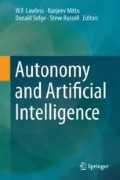Abstract
We explore how children with autism (CwA) learn to interact and what kind of difficulties they experience. Autistic reasoning is an adequate means to explore team formation because it is rather simple compared to the reasoning of controls and software systems on one hand, and allows exploration of human behavior in real-world environment on the other hand. We discover that reasoning about mental world, impaired in various degrees in autistic patients, is the key parameter of limiting the capability to form the teams and cooperate. While teams of humans, robots and software agents have a manifold of limitations to form teams, including resources, conflicting desires, uncertainty, environment constraints, children with autism have only a single limitation which is reduced reasoning about the mental world. We correlate the complexity of the expressions for mental states children are capable of operating with their ability to form teams. Reasoning rehabilitation methodology is described, as well as its implications for children behavior in the real world involving interactions and including cooperation and team formation.
Access this chapter
Tax calculation will be finalised at checkout
Purchases are for personal use only
References
Bai Q. and Zhang, M.,2005a. Dynamic Team Forming in Self-Interested Multi-Agent Systems. Sydney, Australia, LNAI Vol 3809, Lecture Notes in Artificial Intelligence, Springer-Verlag Berlin Heidelberg, pp. 674-683.
Bai Q. and Zhang, M.,2005b. Flexible Agent Team Forming in Open Environments, In Proceedings of the Fifth International Conference on Intelligent Technology, Phuket, Thailand, pp. 402-407.
Baron-Cohen, S., 1989. The autistic child's theory of mind: a case of specific developmental delay. Journal of Child Psychology and Psychiatry, 30, 285-297.
Bogdashina, Olga. Communication Issues in Autism and Asperger Syndrome: Do We Speak the Same Language? Jessica Kingsley Publishers, 2005.
Dawson M, Soulières I, Gernsbacher MA, Mottron L. The level and nature of autistic intelligence. Psychol Sci. 2007 Aug;18(8):657-62.
Erikson, Erik H. (1968) Identity, youth, and crisis. New York: W. W. Norton.
Galitsky B. (2000) Simulating autistic patients as agents with corrupted reasoning about mental states. AAAI FSS-2000 Symposium on Human Simulation, Cape Cod, MA.
Galitsky B., Shpitsberg I. Evaluating Assistance to Individuals with Autism in Reasoning about Mental World. Artificial Intelligence Applied to Assistive Technologies and Smart Environments: Papers from the 2015 AAAI Workshop.
Galitsky B., Shpitsberg I. 2006. How one can learn programming while teaching reasoning to children with autism. AAAI Spring Symposia Stanford CA.
Galitsky, B. 2003. Natural language question answering system: technique of semantic headers. Advanced Knowledge Intl. Adelaide Australia.
Galitsky, B. 2007. Handling representation changes by autistic reasoning. AAAI Fall Symposium - Technical Report FS-07-03, pp. 9-16.
Galitsky, B. & Goldberg, S. 2003. On the non-classical reasoning of autistic patients. International Conference on Neural and Cog-nitive Systems Boston University, MA.
Galitsky, B. 2013. A computational simulation tool for training autistic reasoning about mental attitudes. Knowledge-Based Sys-tems, Volume 50, September 2013, Pages 25–43, 2013.
Galitsky, B. and Peterson, D. 2005. On the Peculiarities of Default Reasoning of Children with Autism. FLAIRS-05.
Galitsky, B. 2016. Computational Autism. Springer Human–Computer Interaction Series.
Galitsky, B., de la Rosa JL, Boris Kovalerchuk, B. 2011. Discovering common outcomes of agents' communicative actions in various domains. Knowledge-Based Syst. 24(2): 210-22.
Galitsky, B., Jarrold, W. 2011. Discovering patterns of autistic planning. AAAI Workshop - Technical Report WS-11-16, pp. 2-9.
Galitsky, B., Shpitsberg, I. 2014. Finding faults in autistic and software active inductive learning. AAAI Spring Symposium - Technical Report.
Ghera M, Marshall P, Fox N, Zeanah C, Nelson CA, & Smyke AT (2009). The effects of foster care intervention on socially deprived institutionalized children's attention and positive affect: Results from the BEIP study. Journal of Child Psychology and Psychiatry, 50: 246-253.
Gokcen S, Bora E, Erermis S, Kesikci H, Aydin C. Theory of mind and verbal working memory deficits in parents of autistic children. Psychiatry Res. 2009 Mar 31;166(1):46-53.
Lawless, W. F., Llinas, J., Mittu, R., Sofge, D.A., Sibley, C., Coyne, J., and Russell, S. 2013. Robust Intelligence (RI) under uncertainty: Mathematical and conceptual foundations of autonomous hybrid (human-machine-robot) teams, organizations and systems. Structure and Dynamics, 6(2).
Lopes, M., Melo, F. and Montesano, L. 2009. Active Learning for Reward Estimation in Inverse Reinforcement Learning. ECML.
Morsanyi K, Holyoak KJ. Analogical reasoning ability in autistic and typically developing children. Dev Sci. 2010 Jul;13(4):578-87.
Rao, M., P. Georgeff. 1995. BDI-agents: From Theory to Practice. Proceedings of the First International Conference on Multiagent Systems (ICMAS'95).
Stevenson, JL, Gernsbacher MA, 2013. Abstract Spatial Reason-ing as an Autistic Strength. PlosOne. 10.1371/journal.pone.0059329.
Yi, L., Junhao Pan, Yuebo Fan, Xiaobing Zou, Xianmai Wang, Kang Lee. 2013. Children with autism spectrum disorder are more trusting than typically developing children. Journal of Experimental Child Psychology.
Yu, K., J. Bi, and V. Tresp. Active learning via transductive experimental design. In Proceedings of the International Conference on Machine Learning (ICML), pages 1081-1087. ACM Press, 2006.
Zhou, S., Qingcai Chen, and Xiaolong Wang. 2010. Active deep networks for semi-supervised sentiment classification. In Proceedings of the 23rd International Conference on Computational Linguistics: Posters (COLING '10). Association for Computational Linguistics, Stroudsburg, PA, USA, 1515-1523.
Zhu X. Semi-supervised learning literature survey. Computer Sciences Technical Report 1530, University of Wisconsin-Madison, 2005.
Author information
Authors and Affiliations
Corresponding author
Editor information
Editors and Affiliations
Rights and permissions
Copyright information
© 2017 Springer International Publishing AG
About this chapter
Cite this chapter
Galitsky, B.A., Parnis, A. (2017). How Children with Autism and Machines Learn to Interact. In: Lawless, W., Mittu, R., Sofge, D., Russell, S. (eds) Autonomy and Artificial Intelligence: A Threat or Savior?. Springer, Cham. https://doi.org/10.1007/978-3-319-59719-5_9
Download citation
DOI: https://doi.org/10.1007/978-3-319-59719-5_9
Published:
Publisher Name: Springer, Cham
Print ISBN: 978-3-319-59718-8
Online ISBN: 978-3-319-59719-5
eBook Packages: Computer ScienceComputer Science (R0)

